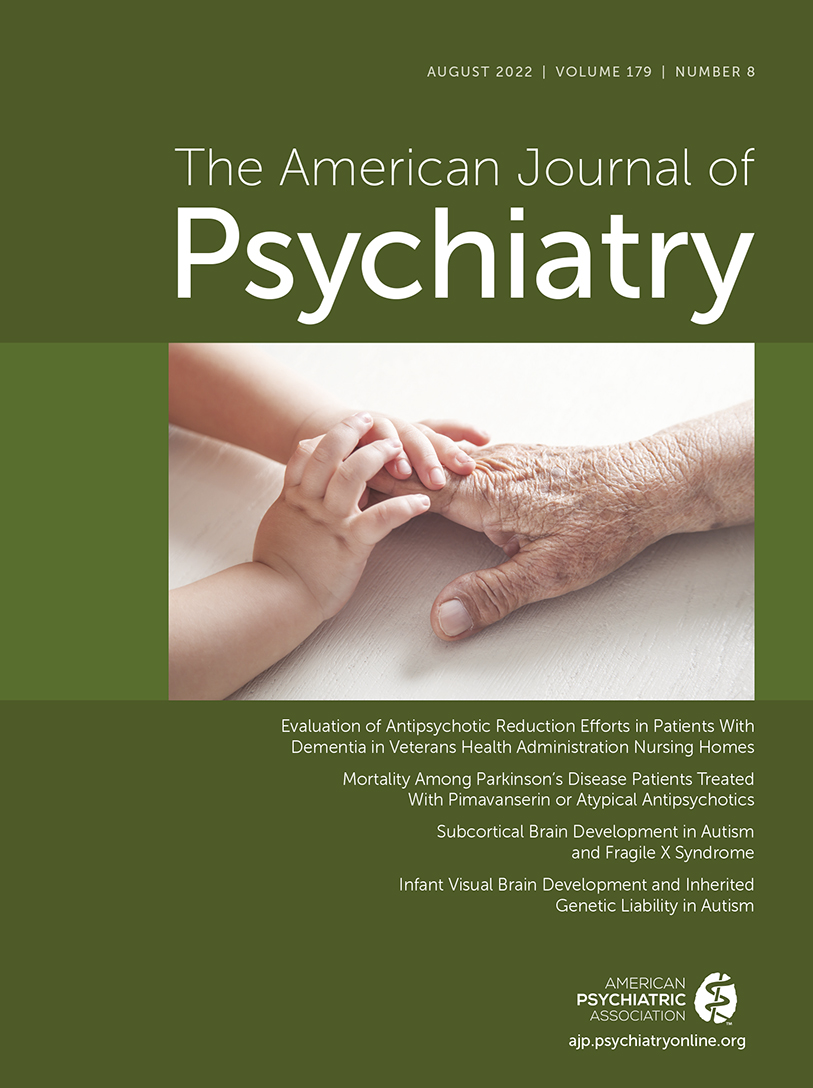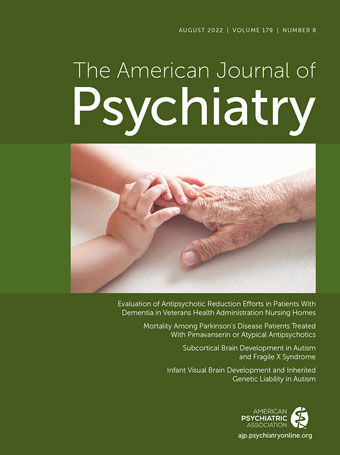Autism affects millions of people worldwide, and access to evidence-based early interventions for all affected children, regardless of geographical location or socioeconomic status, is urgently needed. Efforts to identify biological markers in autism are actively under way, with hopes of identifying intervention targets, opportunities for early intervention, and even prevention. However, the clinical and biological heterogeneity inherent to autism (
1), and nonspecificity of implicated genetic variants (
2), remains a cardinal challenge to the identification of reproducible biological markers that have the potential for clinical translation.
In this issue of the
Journal, Girault et al. (
3) report results from the Infant Brain Imaging Study (IBIS), a longitudinal family-design study. The IBIS sample includes neuroimaging data (acquired at 6, 12, and 24 months of age) and behavioral characterization of infants with increased genetic liability for autism by virtue of having an older autistic sibling (i.e., proband with autism). The study examines whether proband autism traits predict brain phenotypes in infant siblings prior to receiving an autism diagnosis. Specifically, proband autism symptoms (measured using the parent-reported Social Communication Questionnaire [SCQ]) were related to infant sibling multimodal neuroimaging data. Girault et al. cleverly examine whether brain phenotypes that have been associated with autism in previous IBIS reports (
4,
5) track with proband SCQ scores as a proxy marker of genetic liability for autism (
6).
Girault et al. found that increased proband autism symptoms are associated with greater total cerebral volume and total cortical surface area (affecting the right middle occipital gyrus prominently) and higher fractional anisotropy of the splenium of the corpus callosum in infant siblings later diagnosed with autism. These associations were absent in infant siblings without an autism diagnosis. Most strikingly, findings across imaging modalities collectively implicate a relationship between genetic liability for autism and altered development of visual circuitry. These findings add to earlier work from this group, wherein infant siblings later diagnosed with autism exhibited altered development of visual processing brain regions (
4,
5).
Limitations to the study largely reflect the broader challenges associated with conducting longitudinal pediatric imaging research. The present study builds fittingly upon previous research from the IBIS group (
4–
6), yet, as the authors acknowledge, including the same cohort of children across these studies is a limitation. Recent large-scale efforts to identify the source of variable findings across neuroimaging studies have implicated cohort effects as one culprit contributing to lack of replicability (
7,
8). Thus, the unique IBIS data set, a notable strength, is unfortunately also a limitation, given the absence of independent cohorts with comparable data. Although the overall study sample size was respectable (N=384), a much smaller subset of children (N=89) had a concordant autism diagnosis, as expected given that ∼20% of infant siblings of autism probands go on to develop autism. Further, the reported sample was predominantly White, with >50% of parents having a college education or greater, and ∼80% of infant siblings with autism were biological males. That significant findings were observed only in the smaller autism subsample, combined with the unbalanced sample sizes (autism vs. non-autism infants) and limited diversity, underscores the need for replication in larger, more diverse samples.
Another important consideration is that the neuroimaging data analyzed reflect standard practice acquisition parameters at study initiation (>10 years ago). For example, their diffusion imaging sequence contained 25 gradient directions, whereas more directions are typically acquired today, given that it affords the ability to model complex fiber configurations (e.g., crossing fibers). Further, associations found between proband autism symptoms and posterior default mode and visual processing network connectivity at 6 months of age must be considered preliminary. This analysis pooled together a subset of the sample with fMRI data (i.e., 58 infant siblings with fMRI data, including 13 with autism). Nonetheless, it is compelling that findings across gray matter, white matter, and functional neuroimaging measures converged to implicate altered development of visual circuitry as a neural signature of genetic liability for autism in this study.
Lastly, although Girault et al. detected associations between proband traits and infant sibling brain phenotypes in the autism group only, a striking overlap in data points between the autism and non-autism infant groups is evident from their figures. This is not to find fault with the study, but rather to emphasize the pervasiveness of heterogeneity in autism, even among family-design studies. Further constraining heterogeneity will require consideration of candidate genetic factors. It is promising that Girault et al. have identified brain regions (e.g., visual) to assess in future genetic mechanistic studies. The contribution of environmental exposures also warrants investigation, given that genetic and environmental processes may interact transactionally to shape both symptom onset and the trajectory of disorder progression. Fortunately, recruitment of a unique cohort (proposed N=400) for a study incorporating molecular, genetic, and environmental exposure data is actively under way (R01-HD055741), providing the critical opportunity to replicate the present findings and evaluate whether they generalize to an independent sample.
Limitations aside, impactful research stimulates thought-provoking questions for future research. The Girault et al. study undoubtedly excels on this front. The study team deserve praise for their efforts, and their success, in capturing brain and behavioral development in infant siblings of autism probands over the period from 6 to 24 months of age. Interestingly, many of the questions that arise from this longitudinal study have the same flavor as those following cross-sectional studies, broadly captured by: “What happens before, and what happens next?”
Converging evidence indicates that genes enriched in autism are involved in regulatory pathways that influence corticogenesis during prenatal brain development and synaptogenesis in the early postnatal period (
9). The association of genetic liability with brain phenotypes in the present study may be a signature of this early developmental process. Establishing whether genetic liability for autism truly has specificity for visual circuitry, or whether these findings are in essence a developmental by-product, reflective of the rapid expansion of visual cortex in the early postnatal period, is only answerable by assessing what occurs prior to 6 months and after 24 months. An ENIGMA autism working group mega-analysis found case-control differences in subcortical structure, and widespread cortical alterations (
10). However, clustering efforts in autism suggest that subtypes featuring differences in cortical thickness (increases or decreases) may be downstream to underlying genetic profiles (
11).
Many genes implicated in autism are associated with other psychiatric disorders that share similar morphometric case-control differences (
12), suggesting overlap across related conditions. Subtyping neurodevelopmental disorders based on brain-behavior relationships yields transdiagnostic subgroups (
13). Conversely, ENIGMA findings suggest that brain structure alterations across autism, attention deficit hyperactivity disorder, and obsessive-compulsive disorder are neither common across disorders nor stable throughout development (
14). Dynamic changes in brain properties associated with autism (and other neurodevelopmental disorders) may relate to heterotopic continuity, a concept traditionally applied to psychiatric comorbidity whereby symptoms of a particular diagnosis that are present at a given developmental time point may predict characteristics of a different diagnosis later on (
15). From this perspective, early neurodevelopmental processes that significantly alter cortical development (e.g., pronounced effects on the visual system during infancy) could have cascading developmental effects in childhood and beyond.
Through their longitudinal family-design study, Girault et al. demonstrate that inherited liability for autism is reflected in early brain phenotypes and foreshadows the onset of characteristic autistic symptomology in infant siblings. Their findings have important implications for early detection, presymptomatic intervention, and the development of novel interventions. How such findings will support optimal outcomes and enable autistic individuals to lead fulfilling lives, however, requires additional longitudinal research that tracks behavioral and neurobiological development past infancy and across current diagnostic boundaries. Stakeholders must also be actively engaged in tailoring funding opportunities for studies that address topics of critical importance to the autism communities. Only then will the field be positioned to answer questions that are prerequisites for scalable, internationally available interventions, such as those brought forward by the Lancet Commission on the Future of Care and Clinical Research in Autism (
16): What interventions work for which individuals, when do they work, and in what amount are they required?

